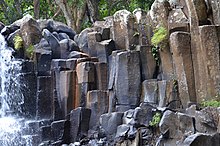
Back Ozeanischer Inselbasalt German Basalte d'île océanique French Basaltos das ilhas oceânicas Portuguese Океанічний острівний базальт Ukrainian


Ocean island basalt (OIB) is a volcanic rock, usually basaltic in composition, erupted in oceans away from tectonic plate boundaries. Although ocean island basaltic magma is mainly erupted as basalt lava, the basaltic magma is sometimes modified by igneous differentiation to produce a range of other volcanic rock types, for example, rhyolite in Iceland, and phonolite and trachyte at the intraplate volcano Fernando de Noronha.[1] Unlike mid-ocean ridge basalts (MORBs), which erupt at spreading centers (divergent plate boundaries), and volcanic arc lavas, which erupt at subduction zones (convergent plate boundaries), ocean island basalts are the result of intraplate volcanism. However, some ocean island basalt locations coincide with plate boundaries like Iceland, which sits on top of a mid-ocean ridge, and Samoa, which is located near a subduction zone.[2]
In the ocean basins, ocean island basalts form seamounts,[3] and in some cases, enough material is erupted that the rock protrudes from the ocean and forms an island, like at Hawaii, Samoa, and Iceland. Over time, however, thermal subsidence and mass loss via subaerial erosion causes islands to become completely submarine seamounts or guyots. Many ocean island basalts erupt at volcanic hotspots, which are thought to be the surface expressions of melting of thermally buoyant, rising conduits of hot rock in the Earth's mantle, called mantle plumes.[4] Some such hotspot volcanic chains are believed to have started with the formation of large igneous provinces. Mantle plume conduits may drift slowly, but Earth's tectonic plates drift more rapidly relative to mantle plumes. As a result, the relative motion of Earth's tectonic plates over mantle plumes produces age-progressive chains of volcanic islands and seamounts with the youngest, active volcanoes located above the axis of the mantle plume while older, inactive volcanoes are located progressively farther away from the plume conduit (see Figure 1).[2] Hotspot chains can record tens of millions of years of continuous volcanic history; for example, the oldest seamounts in the Hawaiian–Emperor seamount chain are over 80 million years old.
Not all ocean island basalts are the product of mantle plumes. There are thousands of seamounts that are not clearly associated with upwelling mantle plumes, and there are chains of seamounts that are not age progressive. Seamounts that are not clearly linked to a mantle plume indicate that regional mantle composition and tectonic activity may also play important roles in producing intraplate volcanism.
- ^ Weaver, Barry L. (October 1990). "Geochemistry of highly-undersaturated ocean island basalt suites from the South Atlantic Ocean: Fernando de Noronha and Trindade islands". Contributions to Mineralogy and Petrology. 105 (5): 502–515. Bibcode:1990CoMP..105..502W. doi:10.1007/BF00302491. S2CID 128694689.
- ^ a b Jackson, Matthew Gerard (2016). "Oceanic Island Basalts". Encyclopedia of Geochemistry. Encyclopedia of Earth Sciences Series. pp. 1–5. doi:10.1007/978-3-319-39193-9_248-1. ISBN 978-3-319-12127-7.
- ^ Staudigel, Hubert; Koppers, Anthony A.P. (2015). "Seamounts and Island Building". The Encyclopedia of Volcanoes. pp. 405–421. doi:10.1016/b978-0-12-385938-9.00022-5. ISBN 9780123859389.
- ^ French, Scott W.; Romanowicz, Barbara (2 September 2015). "Broad plumes rooted at the base of the Earth's mantle beneath major hotspots". Nature. 525 (7567): 95–99. Bibcode:2015Natur.525...95F. doi:10.1038/nature14876. PMID 26333468. S2CID 205245093.